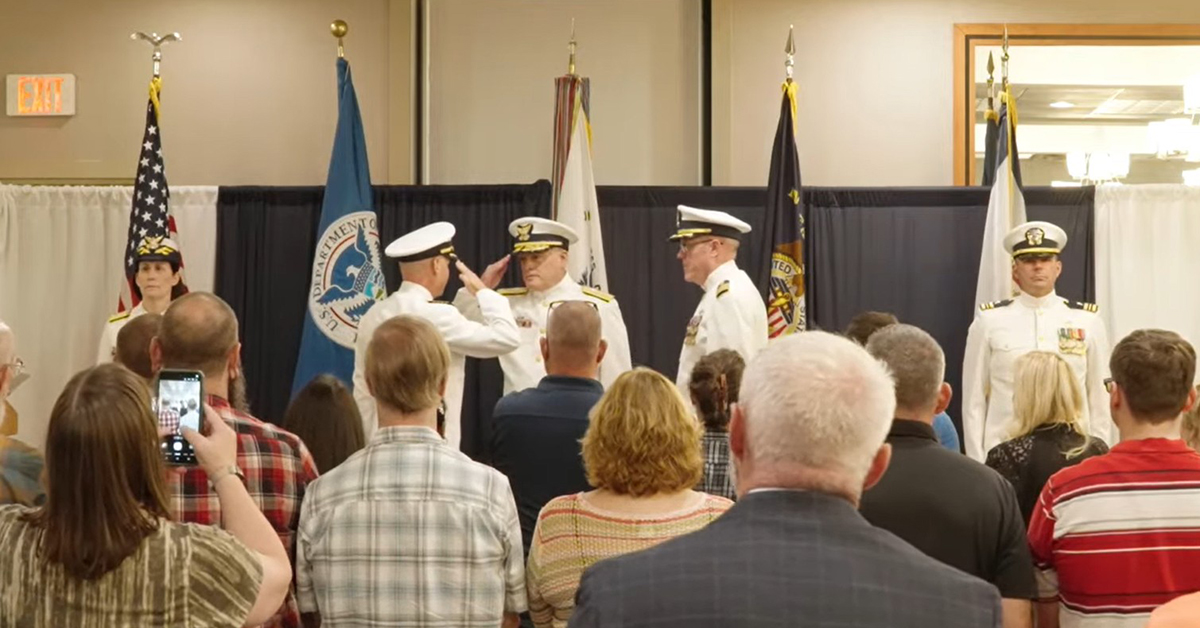The National Maritime Center announced new application status and credential verification tools during a July 25 change of command ceremony in Martinsburg, W.Va.
Rear Adm. Wayne Arguin Jr. presided over the ceremony, where Capt. Patrick Drayer relieved Capt. Bradley Clare as NMC commander. It was followed by a retirement ceremony for Clare, who served 29 years in the military. Both were broadcast live on YouTube.
As the U.S. Coast Guard’s assistant commandant for prevention policy, Arguin is responsible for the development of national policy standards and programs promoting marine safety, security and environmental stewardship. Three directorates carry out the mission: inspections and compliance, marine transportation systems and commercial regulations and standards. Programs include waterways management, navigation and boating safety, ports and facilities, merchant mariner credentialing, vessel documentation, marine casualty investigation, commercial vessel inspections and port state control.
Arguin spoke about the significance of the work the NMC does as well as the challenges from a leadership perspective, adding that Clare did an exceptional job of balancing those tasks “and at the end of the day be able to deliver on customer service.”
“That is the key for what the National Maritime Center is all about,” Arguin said. “At the end of the day it’s about ensuring that with each interaction we have the same sense of urgency that the individual who is submitting that application has. It has a direct implication on their job, their daily livelihood, and it’s important to keep that in mind of every single person who has a direct touch on that application. That’s vitally important to be able to deliver on what the American public expects of us.”
Clare led 325 people spread out throughout the nation “with the sole focus of ensuring those who go to sea have the right credentials and have the right backgrounds to be able to ensure that our national security and our national economy are preserved,” Arguin said.
Clare transferred into the command in July 2021 at a time when widespread fraud and abuse had been discovered in the system, Arguin said.
“It took a monumental effort, not only to ensure we were doing the processes that we needed to do, but also to be able to ensure that those processes are constantly being refined,” Arguin said. “Behind the scenes, most people didn’t really see the challenges we worked through to try to evaluate our own processes but to still be able to deliver on products and ensure the timeliness as best we could while we transitioned our own oversight of that program.”
Arguin added that Clare was able to restore confidence in the system, putting controls in place to ensure that those who received credentials had met the standards expected both domestically and internationally.
Annually, the NMC processes about 200,000 individual transactions, including first time licenses issued and upgrades to existing licenses. The work includes verifying medical fitness and suitability of mariners based on their backgrounds in what Arguin called an increasingly complex maritime transportation system.
In the middle of Clare’s tour, Congress gave the Coast Guard additional tools to address sexual assault and sexual abuse within the maritime system, Arguin said.
“Probably the most challenging part, though, for the National Maritime Center, is it required us to go back through every single credentialed mariner’s background and ensure that there were no derogatory issues that would preclude them from being able to continue to hold that credential,” Arguin said.
Arguin said he had been asked many times why this is a Coast Guard issue, and his answer was that at the end of the day it was his job to ensure the safety and security of the Marine Transportation System and all those working within it, to ensure they were treated fairly, were provided with opportunities and that they did not work in a toxic environment.
“We are making strides to ensure that every mariner has a safe workplace,” he said. “That is a critical feature in us being able to restore American maritime dominance, and the National Maritime Center plays a center point in that capability.”
Arguin also pointed to an internal innovation and focus on improvement and gaining efficiencies under Clare’s leadership.
“Probably one of the most significant moves was to retire the printer,” Arguin said, referring to antiquated printers that previously created mariner credentials in a passport-style booklet format.
While Arguin admitted the new format has been controversial in some circles, he said he believes “most people prefer to have a credential they can work with than to have to wait another couple of months while we get the paper from a certain place and get the hardware where we needed it to be.”
Moving forward, the Coast Guard is going through another major transition with the implementation of Force Design 28, under which Congress authorized the Coast Guard to receive more than $25 billion to recapitalize aging assets, restore shoreside infrastructure and modernize its information technology systems, Arguin said.
“We are just beginning that process, but I can tell you that process is moving out with speed and haste, recognizing where we’ve been in the past and where we need to be in the future,” Arguin said.
That focus includes eliminating duplicative regulations, those that don’t make sense or those that otherwise “add burden to an industry that is already challenged,” he said.
Teams have identified, with engagement from industry, more than 400 areas of either policy regulation or oversight requirements that the Coast Guard should be considering, Arguin said.
“We’ll do so by reducing burden, but we’re not going to compromise safety,” he said.
New Web-Based System
As part of that work, Arguin announced new web-based tools available on the NMC website designed to assist mariners and industry stakeholders with tracking mariner credential application statuses and verifying mariner credentials.
New releases signed by Drayer as the new officer in charge of marine inspections went out within minutes of Arguin’s announcement.
The application status tool allows users to receive application status updates via email instead of having to go through a call center. The mariner credential verification tool provides credential verification via email for both merchant mariner credentials and medical certificates.
In each case, users must provide the mariner’s last name, reference number and a valid email address. Data is updated Monday through Friday by 8 a.m. Eastern Time.
Those who have questions or need assistance may still contact the NMC Customer Service Center Monday through Friday from 8 a.m. to 5:30 p.m. Eastern Time by using the Live Chat feature of the NMC website, calling 1-888-IASKNMC (427-5662) or emailing iasknmc@uscg.mil.
Arguin said other policy improvements will be coming soon, including those designed to fully modernize the processes and the systems that the NMC uses to evaluate a mariner’s information.
“It is a legacy system built on the back of a probably 1980s Access database,” he said. “We’re going to modernize that and fully digitize the system. We’ve called that system Navita (Latin for mariner), and I truly believe within the next month or so we will be able to make an announcement about moving out on fully modernizing not only the systems that we use but the processes that we use to re-engineer the business of credentialing. I’m super excited about that because that is not going to transform not only the transparency and accountability for our system, but it will make things move much faster. Individuals will be able to tell where they’re at in the pipeline, and it will make a much more dedicated, customer-focused experience for all mariners.”
In Clare’s remarks, he also expressed support for the modernization of the system.
“The fact that the Coast Guard is working toward a new system is very exciting,” he said. “It’s going to be transformational.”
Incoming Commander
Before assuming command of the National Maritime Center, Drayer most recently served as the Coast Guard’s liaison officer in Australia, beginning in August 2023. He has also served as the commanding officer of Marine Safety Unit Valdez in Valdez, Alaska, as the executive officer of Marine Safety Unit Duluth in Duluth, Minn., and as assistant supervisor of Sector Miami’s port operations field office at the Port of Miami. From 2003 to 2005, he was a staff officer at the National Maritime Center.
Drayer has served in the Coast Guard more than 23 years. During that time, he has built experience as a passenger vessel safety specialist and as a marine accident and regulatory compliance investigator.
He has an associate’s degree from Northwestern Michigan College in marine science/merchant marine officer and was a cadet at the Great Lakes Maritime Academy, a division of the college. Drayer received his bachelor’s degree in business/maritime transportation from Ferris State University in Big Rapids, Mich. He also received his joint professional military education from Air University–Air Command and Staff College. Most recently he received an occupational endorsement certificate as a millwright from the University of Alaka–Anchorage.
Drayer has also volunteered as a member of the Providence Valdez Hospital Advisory Council, where he advocated for members of the local Coast Guard community to the local hospital and health care providers and served on the University of Alaska–Anchorage’s college council, representing the Coast Guard community within the college network.
“Command of any Coast Guard unit is a privilege, and it’s a duty that one cannot take lightly,” he said. “Command of a unit like the National Maritime Center, the one place in the country responsible for certifying the competence and capabilities of our nation’s merchant mariners, brings with it an additional burden. If we do not do our duty, then the entire country’s in jeopardy. We truly have a no-fail mission.”
Drayer added, “The United States is a maritime nation. Our merchant mariners are the unbreakable link ensuring that the United States remains strong in today’s competitive space. If I’ve learned anything in the past few years, it’s how competitive the world really, truly is. Our job at the National Maritime Center is to ensure that we keep our mariners sailing.”
Featured image caption: Incoming National Maritime Center commander Capt. Patrick Drayer (left) and Rear Adm. Wayne Arguin Jr. salute each other as outgoing commander Capt. Bradley Clare looks on during a July 25 command change ceremony. (Screenshot)




